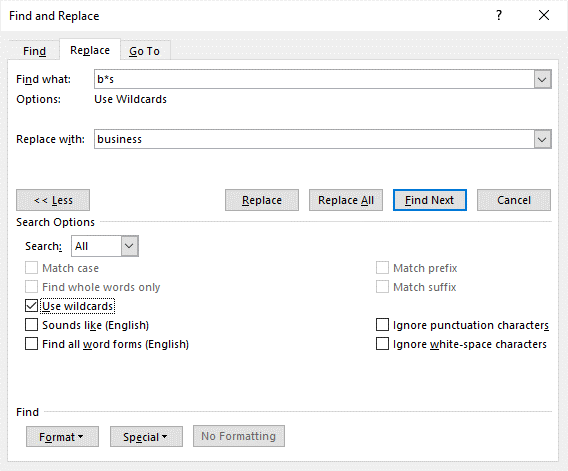


We want to remove all of the date and time stamps from this document without visiting each line manually.
#How to use wildcards in microsoft word find and replace how to
The problem, of course, is how to get rid of those date and time stamps. The system that generates the transcript of the chat stamps each line with the current date and time, as shown in Figure A. (You can read excerpts from the transcript here. Recently my colleagues at TechProGuild, TechRepublic’s subscription-based service, invited me to host an online chat about tech support. Here’s how that feature saved the day for me recently. That capability can save you and your users lots of editing time. However, by the time you do that, you might as well just delete the strings manually after you’ve selected them.įortunately, the Find and Replace dialog box lets you use wildcard characters to locate similar (but non-identical) character strings. You just globally replace the character or phrases with nothing.īut what if the character strings aren’t all the same? You could resort to copying the strings and pasting them into the Find and Replace dialog box. Have you or your users ever opened a file in Word only to discover that the document contained a lot of “garbage” or extraneous characters? Chances are, you probably used Word’s find and replace feature to clean it up. Jeff Davis demonstrates how this advanced feature works. There's one thing users don't realize about Word's Find and Replace featureyou can use wildcards to "find" strings that are similar but not identical. See pages 342–349.Using wildcards when you find and replace in Word The “Replace with” string inserts the single number found, the two numbers found together, an en dash, the same single number found (using \1 again), and the last two numbers found, giving us this: The “Find what” string finds a single number (one through nine, in the first group), followed by any two numbers (in the second group), followed by a hyphen, followed by any two numbers (in the third group). So what’s the deal with the ) Replace with: Put a checkmark in the “Use wildcards” box.Īll those multiple spaces will be replaced by a single space-in one operation!.If the “More” button is showing, click it.In the “Replace with” box, type a single space.In Word’s “Find what” box, type a single space.Display Word’s “Replace” dialog by pressing CTRL + h on your keyboard.But there is a better solution: Use wildcards. In that case, you’ll need to hit “Replace all” multiple times to clean up the problem. Or, worse, the professor has used multiple spaces to indent paragraphs or do other kinds of formatting. Unless, as often happens, old Professor Griggs has been sloppy and sometimes used three spaces in a row. Turning two spaces into one is easy enough: just put two spaces in Microsoft Word’s “Find what” box, one space in the “Replace with” box, and hit the “Replace all” button. Those of us who learned to type on an actual typewriter were taught to put two spaces between each sentence, supposedly to help with readability, and there are still plenty of academics who cling to that outmoded practice. Wildcard Search #1: Replacing Double Spaces In fact, I’m going to give you seven easy wildcard searches you can use right now to help clean up that manuscript and beat that deadline. Using wildcards is not as hard as you might think. If only you knew how to use wildcard find and replace! But now that deadline is looming, and there’s still a lot of work ahead. Your anguished cry rings out in the middle of the night: “Why, oh why, did I accept this stupid freelance job?” You know the answer: The client offered you twice as much money as you’d ordinarily get for a job like this because the deadline is tight.


 0 kommentar(er)
0 kommentar(er)
